









| European Mantis (Mantis religiosa (Linnaeus, 1758)) |










|
|
Scientific name: Mantis religiosa (Linnaeus, 1758) Common name: European Mantis Other names: Praying Mantis French name: Mante religieuse Order: Dictyoptera Family: Mantidae Wingspan : 5 to 8 cm. Males are smaller and more slender than females. Biotope: Hot habitats with bushes and high grasses, with a preference for well exposed and sunny slopes. Geographic area: Africa, Mediterranean Europe, Asia east to Japan. Introduced to North America. Observation period : You can observe adults from August to November. |
European Mantis can be green or brown and sometimes yellowish. They have well-developed "raptorial" fore legs with spines which they use to capture their preys, very often crickets or grasshoppers. The inner side of the fore legs, on the coxa, shows a black-ringed white spot or only a black patch. Mantis religiosa is the only Mantidae showing this criteria in Europe. The triangle-shaped head shows two large prominent widely spaced eyes and three little ocelli on the top. The head is very mobile and can rotate by 180 degrees. There are eight visible sternites on the under side of males' abdomen and only six on females. Both sexes have two pairs of wings. The leathery fore wings (or elytra) protect the membranous and clear hind wings. Both sexes can fly but heavier females loose this ability when approaching the period they will lay their eggs. Mating can last several hours and, sometimes, at the end, the female will kill and eat the male starting with the head. The females lay from 200 to 300 eggs in an egg case (ootheca) which solidifies and becomes very hard at the contact of air. The eggs over winter. Hatching occurs in May or June. Young mantis are similar to adults and the development cycle includes six moults. In France, the only possible confusion, when you have no view of the inner side of the coxa of the fore legs (black patch on Mantis religiosa), is with the Mediterranean Mantis (Iris oratoria). You can tell this last species apart with its short wings, the five spines located on the outer edge of the fore femora (only 4 spines on Mantis religiosa), the presence of two tubercles on the frontal disc and a basal bluish purple patch on the hind wind (visible in flight). |
| [To know more about the European Mantis] [Next picture] [Top] |
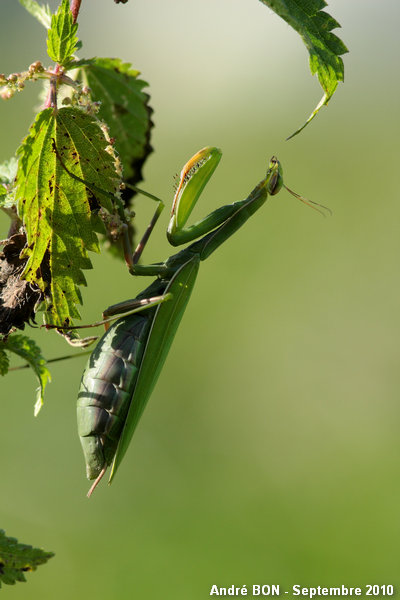
|
I have observed this European Mantis in a place covered with nettles. This place is perfect to find food as many other insects are growing here. I have allowed myself to bend some stems so that I can get a simple and uniform background for the picture. The six sternites are clearly visible on the under side of this female's abdomen. |
| [To know more about the European Mantis] [Next picture] [Previous picture] [Top] |
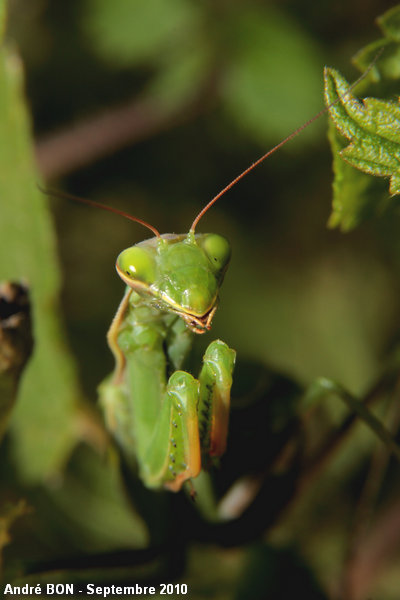
|
I was wondering what could be these moving black dots on the European Mantis compound eyes. They always seem to move to look at you. In fact this is a kind of visual illusion. The compound eyes, made up with many single units (called ommatidia), are not mobile. These ommatidia are some kinds of tubes with different orientation. We can only see the inner end of this tube when it is exactly in our axis of view and this inner end is black. Then the black dots we can see on the Mantis' eye are not moved by the Mantis but depends of our position to look at it "deep in the eyes" |
| [To know more about the European Mantis] [Next picture] [Previous picture] [Top] |
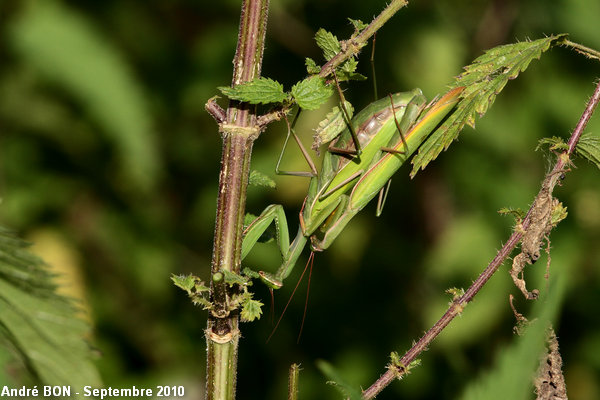
|
I went back on the next morning to see the Praying Mantis. I have then observed this mating. |
| [To know more about the European Mantis] [Next picture] [Previous picture] [Top] |
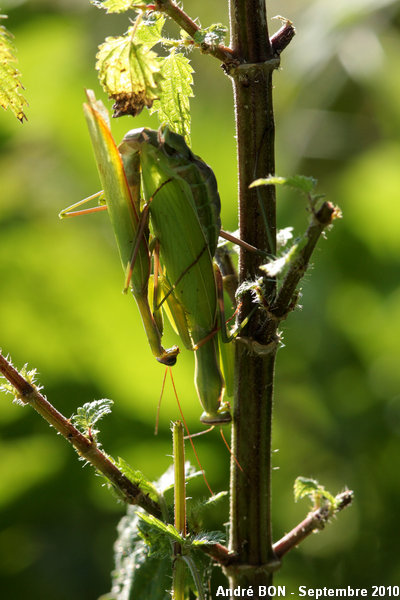
|
I have observed this mating since 8h30 am. I have waited to see the end. Having other obligations, I have been away from 10 to 12. When I came back, about at noon, I found the female alone. So I do not know if the male has been able to escape or if it has been killed by the female. |
| [To know more about the European Mantis] [Next picture] [Previous picture] [Top] |
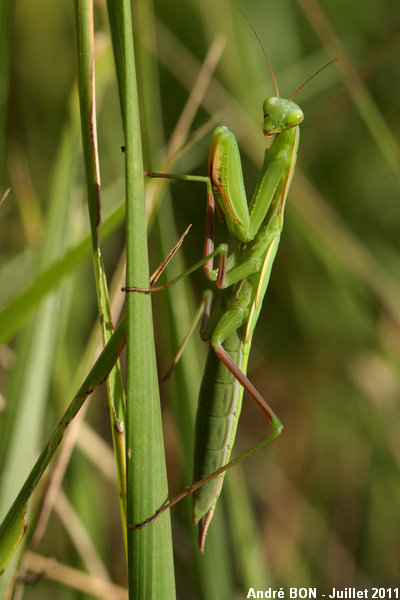
|
I have found a population of European Mantis in a dry meadow not far from my home in the region of Paris. This is the northern limit of the range of this species which is rather considered as a Mediterranean species. |
| [To know more about the European Mantis] [Next picture] [Previous picture] [Top] |

|
European Mantis is listed as a protected species in the region of Paris. It would be maybe better to protect the habitat in places where this species is observed by forbidding the access of motor vehicles as an example. |
| [To know more about the European Mantis] [Next picture] [Previous picture] [Top] |
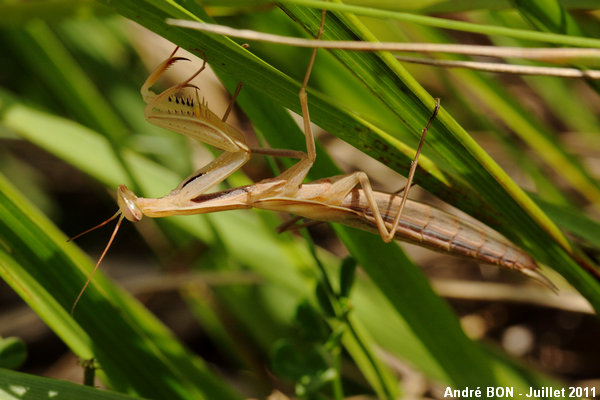
|
Here is a brown specimen which was very difficult to see among high grasses. |
| [To know more about the European Mantis] [Next picture] [Previous picture] [Top] |
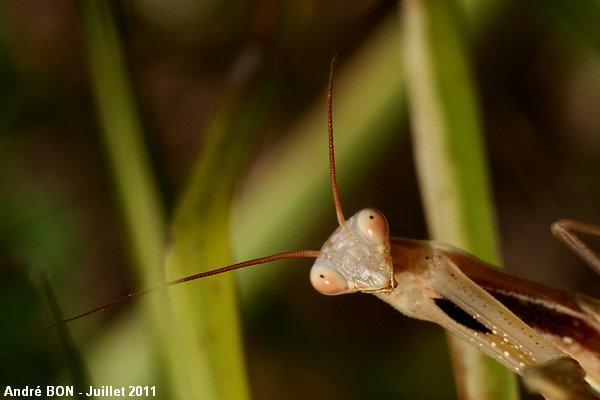
|
I do not know if European Mantis are so numerous here from year to year. I have observed seven of them, in less than one hour, this summer 2011, walking about 200 metres among high grasses. |
| [To know more about the European Mantis] [Next picture] [Previous picture] [Top] |
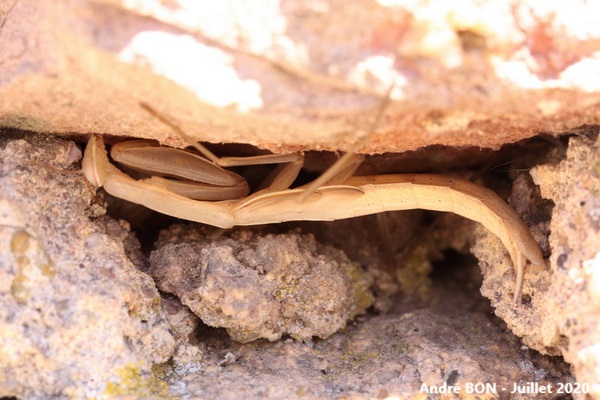
|
Here is a specimen whose yellowish colour seems well adapted to stay unnoticed in a hollow of this dry stone wall. |
| [To know more about the European Mantis] [Previous picture] [Top] |
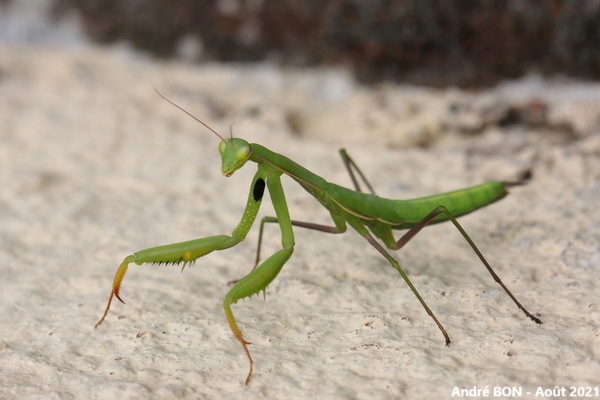
|
The elegant walk of the Praying Mantis. |